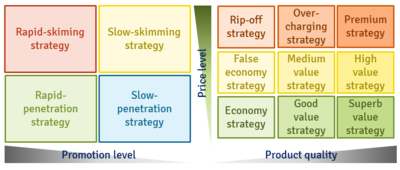Customary pricing
| Customary pricing |
|---|
| See also |
Customary pricing occurs when a retailer sets prices for goods and services and seeks to maintain those prices over an extended period of time. Movies and vending-machine products are common examples of items that use customary pricing. Here retailers, such as movie theaters with their $8 ticket prices, seek to establish prices that customers can take for granted over long periods of time[1].
Setting an appropriate price for a product is often much more difficult than it appears. If only one insignificant detail of the pricing procedure is overlooked or misjudged, major troubles can develop for the firm. Products are not prized in all countries, so what some may be willing to pay highly for, others may not. In a foreign environment any assumption concering a product's "special value" is dangerous. Unless the market is clearly stablished, the implementation of a high pricing strategy is not likely to achieve high sales volumes[2].
Customer price sensitivity
Responding to locational differences in customer price sensitivity can substantially increase a retailer's profits. Given the availability of scanner data on sales and prices in many retailing operations, it is often practical to base these zones on empirical measurement of customer price sensitivity. Further, if an outlet's customer price sensitivity is tracked separately for different products, then a retailer can set a zone's prices higher for some products but lower for others. For example, a supermarket might find it profitable to increase the gap between national brands and store brands in more affluent neighborhoods because the national-brand buyers there may show very little price sensitivity, but the store-brand shoppers there might be highly price-sensitive[3].
Pricing strategies
Psychological pricing strategies encourage purchases based on emotional responses rather than on economically rational responses. These strategies are used primarily for consumer products rather than business products.These are[4]:
- Odd-number pricing is the strategy of setting prices using odd number that are slightly below whole-dollar amounts. Nine and five are the most popular ending figures for odd-number prices.
- Multiple-unit pricing setting a single price for two or more units, such as two cans for 99 cents rather than 50 cents per can. Especially for frequently purchased products, this strategy can increase sales. Customers who see the single price and who expect evetually use more than one unit of the product regularly purchase multiple units to save money.
- Reference pricing means pricing a product at a moderate level and positioning it next to a more expensive model or brand in the hope that the customer will use the higher price as a reference price. Because of the comparison, the customer is expected to view the moderate price favrably.
- Bundle pricing is the packing together of two or more products, usually of a complementary nature, to be sold for a single price. To be attractive to customers, the single price usually is considerably less than the sum of the prices of the individual products.
- Everyday low prices to reduce or eliminate the use of frequent short-term price reductions. Marketer sets a low price for its products on a consistent basic rather than setting higher prices and frequently discounting them.
- Customary pricing certain goods are priced primarily on the basis of tradition. Examples of customary, or traditional, prices would be those set for candy bars and chewing gum
Footnotes
References
- Dunne P.M., Lusch R.F., Carver J.R., (2010). Retailing, Cengage Learning, Ohio.
- Pride W., Hughes R., Kapoor J., (2009). Business, Cengage Learning, Ohio.
- Ricks D.A., (2009). Blunders in International Business, John Wiley & Sons, Carlton.
- Schindler M., Schindle R., (2011). Pricing Strategies: A Marketing Approach, Sage, New Delhi.
Author: Dawid Barcik
